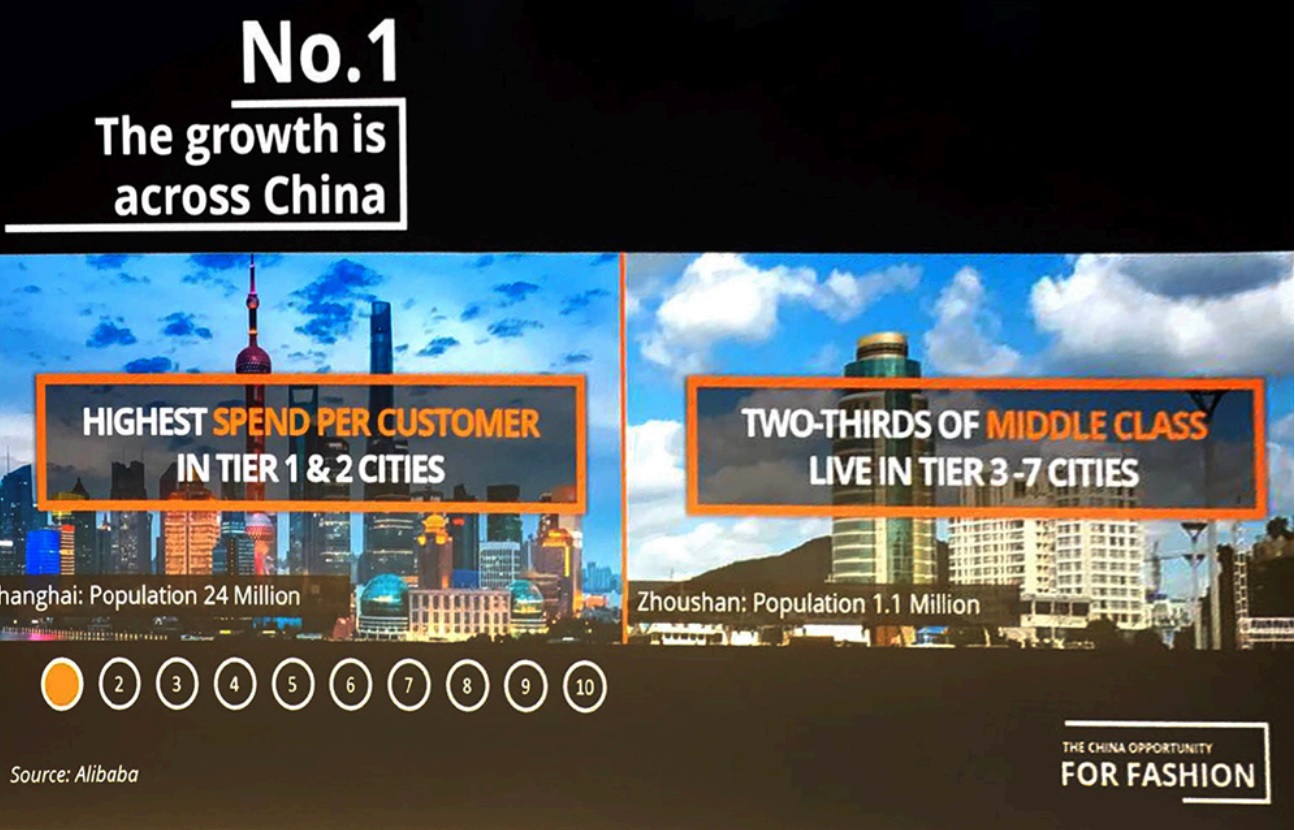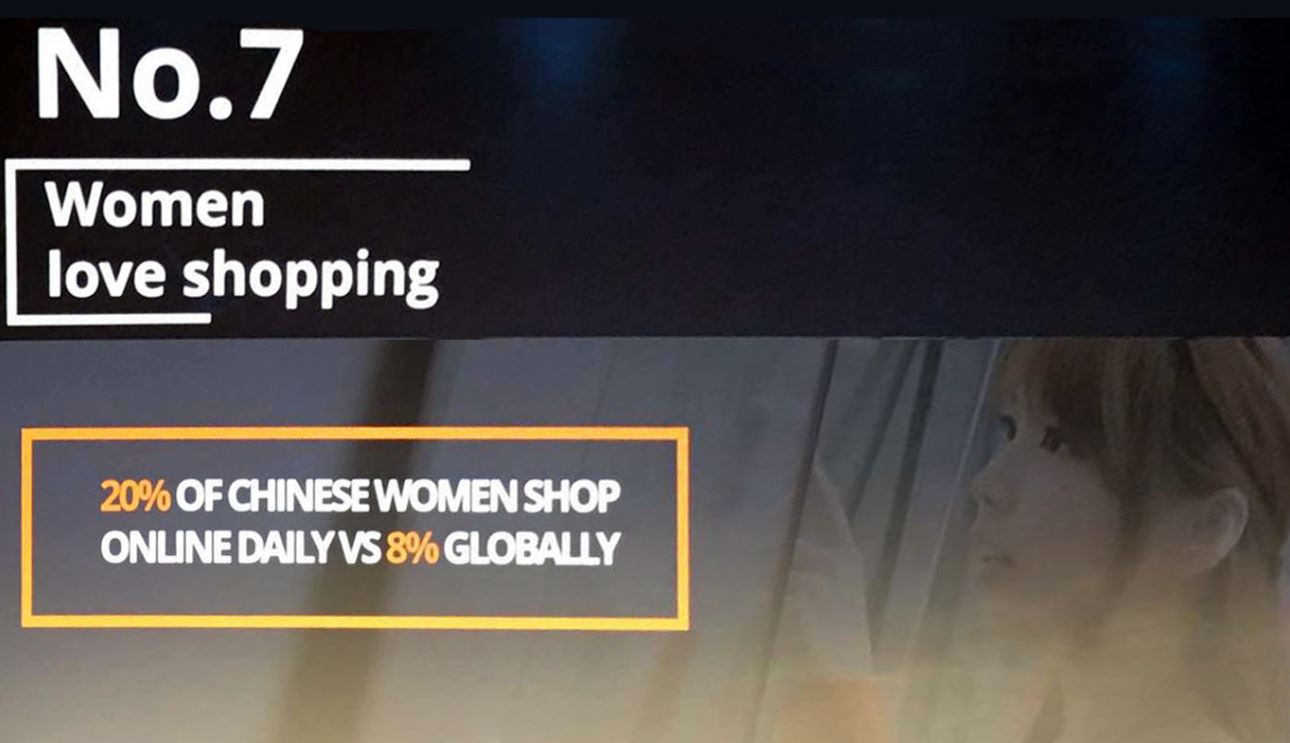1) There is a significant demand for the fashion category in China
China accounted for more than 30% of the growth in the global apparel market in 2015. The Chinese apparel market was valued at $150 billion that year, and iResearch projects that it will reach $195 billion in the next five years.
 Source: Fung Global Retail & Technology
Source: Fung Global Retail & Technology
2) Everyone wants it: demand is strong from first tier cities as well as lower tier cities
Growth in the fashion category is expected to be driven by rising demand from the lower-tier cities, and there are currently 102 cities in China with a population of over 1 million. The combined spending power of consumers in the lower-tier cities is estimated to be roughly the same as the power of consumers in the four Tier 1 cities—Beijing, Shanghai, Guangzhou and Shenzhen. Alibaba’s data indicates that consumers in the lower-tier cities demand the same fashion goods as those in the Tier 1 cities.
3) Apparel category is the first thing Chinese consumer trade up when their income rises
Fashion is the number-one category in which aspirational shoppers in lower-tier cities plan to trade up when their income increases. According to Boston Consulting Group (BCG), 50% of Chinese consumers trade up consumption in fashion as their income improves, as they still see fashion a way to express themselves. The fastest growing categories in fashion are sportswear, lingerie and men’s watches, according to Alibaba’s proprietary data, which are emerging categories that allow for more self-expression.
4) Chinese millennials are the leading consumer group for fashion category in China
The fast-growing demand for fashion in China, especially for foreign fashion brands, is being driven by shoppers under the age of 35. Chinese millennials bought 50% more foreign brands in 2016 than in 2013, according to data from Alibaba’s platform. Also, millennial shoppers are generally the only child in their family, and they often have additional income from their parents and few financial liabilities. They are willing to spend 70%–80% of their discretionary income on fashion, according to Chande.
5) Chinese consumers are spoiled for fashion choices
Chinese consumers are increasing sophisticated in their fashion taste, as a result of the large number of fashion brands available on the market. More than 300,000 foreign fashion brands are already selling in China. Chinese consumers generally prefer foreign fashion brands, as they perceive them as having better quality and more fashion-forward design. Chande shared that the emerging popular areas in fashion are fast fashion, streetwear brands and direct-to-consumer accessible luxury sites in China. Chande cited Tibi, Everlane, and streetwear brand the Mountain as some popular destinations for Chinese fashion shoppers.
6) Chinese consumers are still deal-savvy
Chande noted that young Chinese fashion shoppers are willing to spend a fortune on fashion items as a means of self-expression. Meanwhile, they still love to shop for deals. They are constantly on social media and shopping apps to hunt for deals.
7) Women shoppers are important in China
Female shoppers are particularly important in China. According to PwC, 20% of Chinese women shop online daily versus 8% globally. Foreign brands should tailor to their interests when creating their marketing message. Chande noted that female shoppers are more experience-driven whereas male shoppers are more transactional.
 Source: Fung Global Retail & Technology
Source: Fung Global Retail & Technology
8) Indie fashion brands have a unique opportunity in China
Chinese consumers are becoming increasingly sophisticated. Their motivation for buying foreign brands is transitioning: many no longer seek to represent their socioeconomic status through such goods, but to express their individuality. As a result, they are increasingly interested in niche brands and retailers that offer unique products.
9) China’s fashion market is dynamic marketplace driven by celebrity endorsement
The Chinese fashion market is a dynamic yet competitive marketplace where consumers are always looking for new brands. Brands could rise to fame in China overnight if celebrities wear their products. Chande shared the story of a Chinese celebrity who posted a picture of himself on social media wearing a T-shirt from Detroit-based brand Carhartt; the brand subsequently went viral in China, she said.
10) The American lifestyle is inspirational for Chinese fashion consumers
Many in the rising middle class in China aspire to experience the American lifestyle by purchasing American goods, particularly in categories such as fresh produce and outdoor apparel. For example, outdoor category sales in China are growing because an increasing number of Chinese consumers are interested in exploring outdoor activities as part of their lifestyle. American outdoor apparel brands have the opportunity to introduce the outdoor lifestyle to millions more curious Chinese consumers.
Additional insights from the fashion and apparel panel following the presentation include:
Online penetration in the fashion category is accelerating in China
The fashion category is quickly moving online in China. The current online penetration rate for fashion in China is 13%, and it is expected to reach 20% in the next five years, according to AliResearch and Boston Consulting Group. Jessica Liu, General Manager of Tmall Apparel, noted that the B2C online channel is the fastest-growing channel. Rapid e-commerce infrastructure development and increasing demand for fashion-forward items from consumers in lower-tier cities have contributed to the accelerating growth of e-commerce. Leslie Tse, General Manager of Baozun, a third-party e-commerce partner that helps foreign brands operate their online stores in China, believes that the logistics infrastructure for e-commerce has improved significantly in the past few years in China. For many shoppers in lower-tier cities, where foreign brands do not have much of a physical presence, the online channel offers more on-trend items than their local apparel stores do.
The power of social media in the fashion category cannot be overstated
Social media heavily influences fashion purchases in China, where consumers rely on peer-to-peer recommendations and “cewebrities” (online celebrities) for fashion inspiration. Deborah Weinswig, Managing Director of Fung Global Retail & Technology, said that shopping is a sport in China and that shoppers love to talk about what they bought at social gatherings and on their social media pages. Roth Lai, Deputy Editorial Director of ELLE China, said that the fashion magazine had created video-based content on social media apps in order to drive more engagement.


 Source: Fung Global Retail & Technology
Source: Fung Global Retail & Technology Source: Fung Global Retail & Technology
Source: Fung Global Retail & Technology